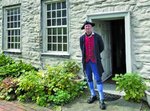

George Taylor rode horseback from his Durham home to Philadelphia in the summer of 1776 to sign the Declaration of Independence.
A member of the Continental Congress, he was ironmaster at the Durham Furnace during the turbulent years of the American Revolution, and a true patriot.
But he is little honored in Bucks County even though he was the only signer from Bucks and one of the Founding Fathers. I’ve often wondered why the county hasn’t bragged a bit about this man, one of only five Pennsylvanians to sign the document. He also directed the production of ammunition at Durham for the Revolutionary War. He’s been more or less sadly overlooked here despite his brilliancy and his wartime contributions.
Perhaps that’s because he moved back and forth from Bucks to both Lehigh and Northampton counties and New Jersey. He lived twice in Durham – from 1757 to 1763 and again from 1774 to 1779. During the ’70s Durham Furnace produced grape shot, cannon balls and cannons for the Continental Army. Taylor received limited income for his contribution to the war effort, and his wealth continued to dwindle.
Or perhaps he’s been neglected due to his association with Joseph Galloway. co-owner of the iron works, Galloway proclaimed himself a Loyalist. Eventually accused of treason, he fled to England.
The house Taylor lived in just outside the Village of Durham still stands. It is privately owned and not open to the public, but the true mansion he had built in Lehigh County was designated as a National Historic Landmark in 1971. One of the few remaining homes of the signers, it is now owned by the Borough of Catasauqua.
Taylor was a wealthy man at the time. Construction of the mansion, according to Jason Kern, president of the George Taylor Association, a volunteer group, said the home would have cost about $1.4 million today. At the time Taylor was an exceedingly wealthy man. He even hired carpenters from Philadelphia to work on the building. An impressive gem, it’s really worth the trip to the Lehigh Valley.
Taylor had emigrated from North Ireland as an indentured servant to 1736 and in just three years was managing Warwick Iron Works in Chester County. Three years later he married the owner’s widow. He moved to Durham in 1757 as co-owner and ironmaster at Durham Iron Works where he apparently amassed a fortune. In 1768 he moved to Lehigh County and built his home at 35 S. Front St. in Catasauqua. His wife died soon after the house was completed and he moved back to Durham.
Join our readers whose generous donations are making it possible for you to read our news coverage. Help keep local journalism alive and our community strong. Donate today.